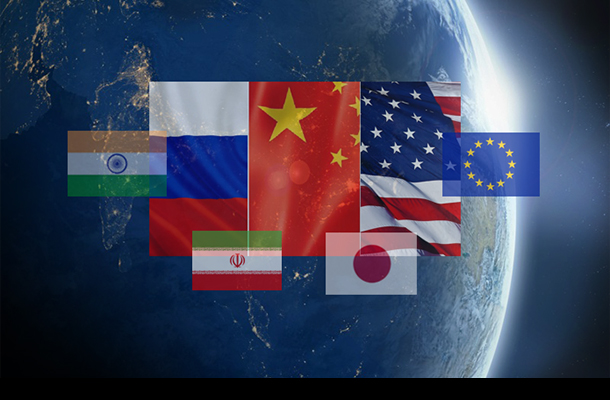
Brian Berletic
21st Century Wire
Introduction
The domain of space has become an increasingly important playing field economically and militarily amid the wider great power game here on Earth.
While mostly out of sight, the satellites circling overhead provide us with precise positioning information for navigation, communication, weather data, intelligence, and imaging for maps so readily available online – we have begun to take this all for granted.
The impact of this technology in orbit on our ability to engage in commerce and maintain military preparedness has become so vital over the past several decades that nations have begun dedicating not only more resources into developing spaceborne capabilities, but also creating the ability to monitor threats in space and develop methods to defend against them.
This has led to several nations creating “space forces,” with the United States creating the US Space Force in 2019. Russia and China also have equivalent military forces dedicated solely to the domain of space – though how they will be used will most certainly differ from how the US will likely (and is already beginning to) use theirs.
What we see unfolding now is geopolitical cooperation and conflict here on Earth being extended into Earth orbit and beyond.
China has begun launching as many, if not more rockets per year than the United States. Its capabilities range from placing entire satellite constellations into orbit, to launching its own astronauts and even space station segments, as well as commercial missions for clients from around the globe.
Russia continues to develop its space launch capabilities and currently still has these most reliable manned space launch systems on Earth – the Soyuz. Their plans to develop reusable rockets to remain competitive with American aerospace company SpaceX means that Russia too remains a significant partner/competitor in the space domain.
And of course, private companies – from the US to China and everywhere in between – are creating capabilities and pursuing objectives beyond existing state-dominated space programs – with US-based SpaceX creating everything from reusable launch vehicles, to satellite internet, to a fleet of stainless steel starships designed to colonize Mars.
And just beyond reach of current technology are resources in space in the form of minerals and ore on the Moon and trapped in near-Earth objects like asteroids that could open the door to a multi-trillion dollar space economy that could sustain a population within our solar system many times larger than the 7.6 billion people on Earth today.
Through this now quickly shifting and rapidly developing space industry we can see the stage being set for a new, and much more wide-ranging “space race” for the 21st century.
While the first space race was bipolar – between the United States and the Soviet Union – today’s new space race includes old adversaries – the US and Russia – as well as China, India, and even Iran. There are also a growing number of private space companies from US-based firms like Elon Musk’s SpaceX and Jeff Bezos’ Blue Origin, to Japan’s iSpace, and Galactic Energy in China.
The Space Economy
There is a very real space-based economy already.
It consists of constellations of satellites providing everything from communication to navigational services – services that are playing an increasingly important role in the global economy.
Industries like delivery services heavily depend on satellite navigation to connect drivers with their destinations, aiding them in navigating to customers and allowing customers to track their progress in real-time. Food delivery alone is an industry of over $100 billion worldwide.
There are also taxi services that increasingly rely on satellite navigation to find and deliver passengers.
The growing importance of satellite navigation for the economy is only set to grow as companies around the globe explore the possibility of drone delivery services and modes of land transportation that are increasingly autonomous.
Communication satellites have long served an important role in advancing and connecting modern information technology. Satellite phones and now satellite internet are services already available around the world. These services depend on satellites in higher orbits over the Earth meaning that latency is higher – and internet speeds slower.

Geostationary orbits, while higher and providing slower communication speeds, require fewer satellites to cover any particular area – with specific satellites assigned to and stationed permanently over a single region of the planet.
Communication satellites in low earth orbit cannot remain over a single region of the planet permanently. They are constantly moving, and thus to create worldwide coverage, shells of constantly moving satellites with protocols meant to relay signals not only from the ground to orbit, but between satellites in orbit are required – and in large numbers.
The lowering costs of both satellite manufacturing and space launches to place them into orbit makes this possible today.
With SpaceX’s Starlink service, consisting of thousands of satellites in low earth orbit (and eventually tens of thousands of satellites), low latency satellite internet will be available worldwide with a partial network already being tested.
Other companies are attempting to create their own low earth orbit constellations including OneWeb and Amazon’s Project Kuiper.
Russia’s Roscosmos is planning to create a similar constellation and China via its Hongyun project is already launching satellites in a bid to create its own low earth orbit broadband internet constellation.
These would constitute global internet service providers – though satellites would still depend on ground stations that connected to the physical backbone of the Internet in order to receive and transmit data – and companies involved in proposing and building these constellations are designing custom tailored solutions on a state-by-state basis to address security concerns in an age where information warfare is as serious a threat as actual warfare.
There are also clear military implications regarding satellite navigation and communication.
Its use on the battlefield includes collecting intelligence, coordinating the locations of and communication between troops in the field, guiding warships at sea as well as warplanes overhead, guiding munitions accurately to their targets and for managing the growing fleet of unmanned military vehicles on land, in the air, and both on and under the sea.
The obvious importance of satellite navigation and communication for both a nation’s economy and its defense is why nations like the United States, Russia, China, and the EU have developed their own networks that they control and that they cannot be excluded from. These are networks that they can offer access to for allies and customers, to enhance their alliances and to open up streams of revenue.
The United States maintains the Global Positioning System (GPS) with a constellation of 31 satellites. The maintenance and protection of America’s GPS satellites was transferred to its newly christened Space Force.
Russia maintains the Global Navigation Satellite System (GLONASS) with 24 satellites in orbit. The EU’s Galileo network also consists of 24 satellites.
China recently completed its BeiDou network with 35 satellites in orbit – the largest network of its kind and one of several key indicators illustrating not only how serious China takes this new space race, but the competence it is able to bring to it.
The BeiDou network has already become a key component of China’s One Belt, One Road initiative. It is space infrastructure China is using to help stitch together the economies of Eurasia and to help augment the military capabilities of its allies – including nations like Pakistan who now have access to BeiDou’s higher military-grade positioning resolution.
Since China is building continent-spanning transportation infrastructure – creating and maintaining its own network of navigation satellites with global coverage prevents nations like the US from cutting it off from the GPS network at junctures of geopolitical tensions and potentially stranding logistical operations across entire continents.
CISLunar Economy
United Launch Alliance (ULA) – a space lift company created by Boeing and Lockheed – has proposed what it calls a “cislunar economy.” Cislunar describes the space between the Earth and the Moon.
ULA’s proposal imagines a cislunar economy reaching $3 trillion by 2050. According to SpaceNews in an article titled, “ULA’s Tory Bruno argues for U.S. investments in the production of fuel in space,” that economy would include mining, transportation, manufacturing and space tourism.
Space.com in an article titled, “Inside ULA’s Plan to Have 1,000 People Working in Space by 2045,” would note just how many people would make up that economy.
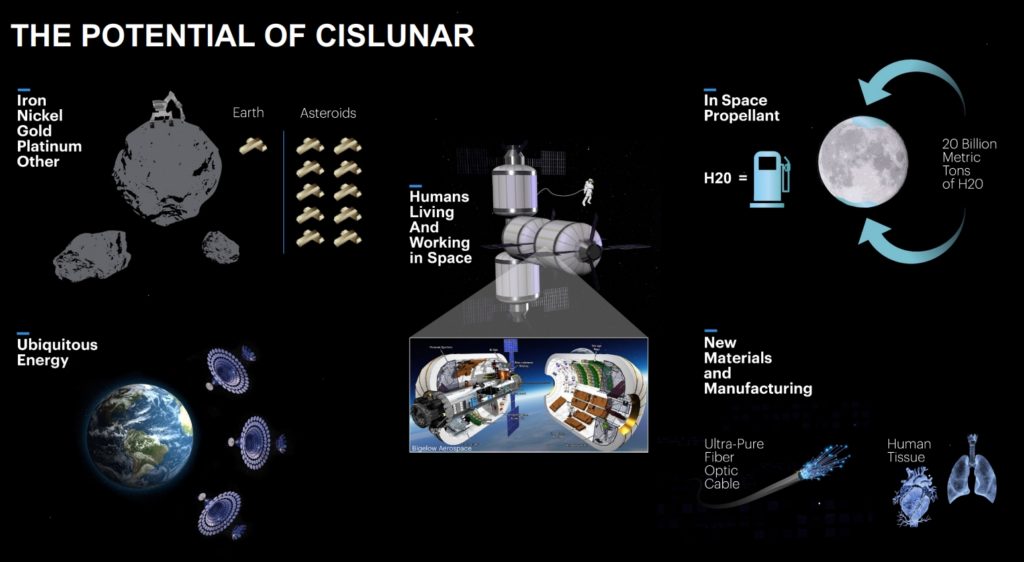
CISLunar economy (Image Source: ULA/NASA)
Mining and in-situ manufacturing in space alone would be transformative for human civilization – akin to moving from the bronze age to the iron age. The resources trapped in near earth objects dwarf the total amount of resources here on Earth. It is just a matter of accessing it and possessing the tools to use it in manufacturing processes in space.
The science fiction future imagined in books and movies for decades could become a reality, complete with orbital habitats not unlike that featured in the 2013 film, “Elysium,” hopefully without the accompanying dystopian class divide.
While ULA’s own expendable launch vehicles are unlikely capable now or anytime in the near future of actually realizing their cislunar economy, other US-based companies and even those abroad might – and sooner than we imagine.
Jeff Bezos – Amazon founder and owner of US-based aerospace company Blue Origin – has proposed a roadmap (video) for the mining of resources and the construction of such habitats. Blue Origin is currently working on its New Glenn rocket – the closest launch vehicle in terms of capability and reusability to SpaceX’s Starship currently under testing. New Glenn, Starship, and similar launch vehicles would be needed to create the foundation of these proposed manned economies in space.
Getting to Space
Space was once the sole domain of a handful of government space programs.
Today, governments, corporations, and a mix of both are now widening the space launch capabilities of countries with space programs, as well as opening increasingly attractive options for nations without their own space launch capabilities.
To date, Russia, the US, Japan, China, the EU, India, Israel, Ukraine, Iran, and North Korea have all demonstrated the ability to launch payloads into orbit.
Currently, China, Russia, and the US lead the world in total launches per year – placing public, military, and commercial payloads into orbit not just for their respective countries but for a wide range of customers from around the world.
China currently leads, or closely follows the US in total launches per year – depending on the year – with US-based SpaceX accounting for America’s ability to continue competing.
The US currently holds the edge in overall competitiveness – again because of SpaceX – and owed in particular to SpaceX’s reusable Falcon 9 launch vehicle. Some of its Falcon 9 boosters have flown and landed up to 8 times (at the time of writing). The boosters are designed to fly up to 10 times before major overhauls.
The merit of reusability has not been lost on America’s main competitors. China has been nurturing its own private space industry and several companies are pursuing Falcon-style reusability including Galactic Energy with its planned Pallas 1 rocket targeting a 2021 test launch. Companies like iSpace are also pursuing similarly reusable launch vehicles. Both companies have already reached orbit with expendable rocket designs.
Russia’s Roscosmos is developing its Amur rocket, following SpaceX’s strategy for reusability using a first stage that launches and lands under the power of its own rocket engines.
SpaceX itself – while continuing to launch its Falcon 9 on a regular basis (26 launches in 2020 alone) – is working on the next generation of reusable launch vehicles – Starship.
It will be the largest, most powerful rocket ever built and feature fully reusable first and second stages. It is designed ultimately not only to send people to Mars, but to be able to lift enough material, equipment, and people into orbit frequently enough to build a city on the red planet.
While this goal remains on a more distant horizon, the cargo lift capabilities of Starship – lifting 150 tons into low earth orbit – and its rapid reusability will make access to space cheaper than ever before. It will open up a variety of possibilities both economically and militarily for the United States and its allies, as well as for commercial partners around the world – while leaving other nations playing catch-up.
Nothing like Starship is even under development elsewhere around the globe. While China and Russia are developing heavy-lift rockets nearing Starship’s lift capabilities, none of them will be even partially reusable.
There is also the ability to reach other places in the solar system – other than Earth orbit. The US, China, Russia, and Japan all possess the capability to reach the Moon, Mars, and even near earth objects like asteroids.
In 2020 when the most recent launch window opened to send missions to Mars, the US and China both sent major missions.
NASA’s Perseverance rover successfully touched down on Mars’ surface earlier this month. The rover contains experiments to retrieve and eventually send back samples of the Martian surface to Earth as part of future missions to Mars, as well as an experiment for in-situ oxygen production which will be vital for human habitation and the production of fuel on Mars in the future.
China’s mission – Tianwen-1 – has also reached the red planet, featuring an orbiter, a lander, and a rover.
If China successfully lands on the surface of Mars it will signify a major milestone for the nation and its spaceborne capabilities. Having already reached Mars orbit and having sent back incredible pictures of the Martian surface – Tianwen-1 has already made a major geopolitical statement.
While critics say China has not done the many things the US has done in space and has a long way to go to catch up – China does not need to replicate America’s past achievements – it merely needs to match or surpass America’s current achievements and is working to do exactly this.
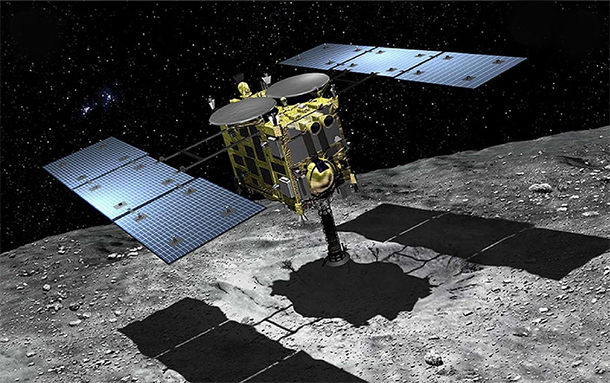
Mission accomplished: Japanese Hayabusa2 carrying asteroid samples in December 2020 (Image: JAXA)
NASA and the Japan Aerospace Exploration Agency (JAXA) have both sent missions to asteroids – a major first step toward eventually exploiting the vast amount of resources trapped in them.
JAXA’s Hayabusa missions both retrieved samples from targeted asteroids and returned them to Earth. NASA’s OSIRIS-REx mission has successfully collected a sample from asteroid Bennu and is slated to return it to Earth by 2023.
Getting into space and being able to reach a wide variety of destinations there – and being able to carry out a wide variety of activities will be key to expanding Earth’s economy into space. Government agencies and private companies are developing these capabilities at an increasingly faster pace each year with large implications regarding cooperation and conflict in space in the near future.
Conflict in Space
The networks being placed into orbit will enhance the economic and military capabilities of the respective nations on the ground launching them. The importance of creating and defending these networks is obvious.
Satellite navigation’s use in conducting warfare and in particularly accurately guiding unmanned aircraft and even munitions across the battlefield makes it an obvious target for electronic jamming.
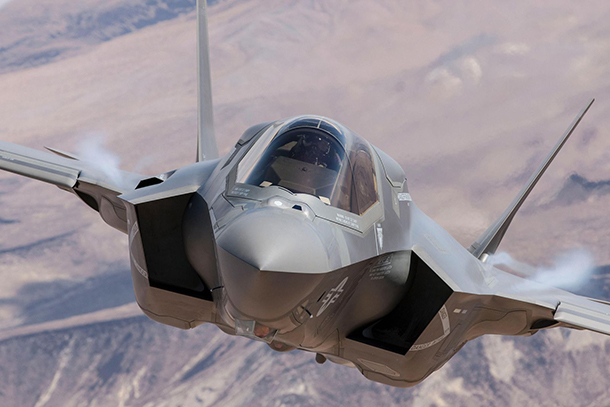
F-35 Fighter (Image Source: Darin Russell/Lockheed Martin)
Here we can see the clearest example of how geopolitical competition on Earth is extending into the domain of space.
The National Interest in a 2019 article titled, “GPS Jammed: Russia Is Messing with America’s F-35s,” would claim:
Russian forces have been jamming GPS systems in the Middle East. The electronic-warfare campaign could affect U.S. forces gathering in the region in advance of potential strikes on Iran.
“Since last spring, pilots flying through the Middle East, specifically around Syria, have noted that their GPS systems have displayed the wrong location or stopped working entirely,” The Times of Israel reported in late June 2019.
GPS is essential for US military operations – and for pilots of warplanes like the F-35 in particular – both regarding navigation and guiding munitions to target. Jamming GPS signals in theater means partially blinding US warplanes and severely inhibiting their ability to carry out military operations.
While the US has claimed this jamming is a serious provocation, Syria is a nation the US has illegally occupied for years. This is in addition to its military occupation of Iraq and Afghanistan and, as the article points out, its planned military aggression against Iran, all nations thousands of miles from America’s shores, and all nations that pose no direct threat to the US itself.
The use of America’s GPS in the Middle East is explicitly for enabling military aggression abroad – not the defense of the United States itself.
With the founding of the US Space Force in late 2019, and with the new armed forces branch overseeing America’s GPS capabilities, it is certain that stopping Russia or any other nation from disrupting these capabilities overseas will become part of its mission.
 It is clear that the US Space Force will be used – not to defend the United States itself – but to prevent others from defending themselves from US aggression and its spaceborne capabilities used to enable it.
It is clear that the US Space Force will be used – not to defend the United States itself – but to prevent others from defending themselves from US aggression and its spaceborne capabilities used to enable it.
Russia’s use of electronic jamming has complicated American aggression in the Middle East. But there are other threats to America’s spaceborne capabilities – and theoretically, to those of all other nations as well.
This includes anti-satellite missiles.
In 2007, when China tested an anti-satellite (ASAT) missile which destroyed one of its aging Fengyun series weather satellites, the West vocally protested – so much so – that many might believe China was the first ever to carry out such a test.
In reality, the US conducted a very similar test as early as 1985 using an ASM-135 ASAT missile mounted on an F-15 Eagle fighter aircraft. The missile was used to destroy the Solwind P78-1 satellite – a scientific platform nearing the end of its lifespan.
The early US test – like the Chinese one in 2007 – created debris that posed a hazard to other satellites and spacecraft in orbit. The US test even delayed the construction of what is now the International Space Station (ISS).
After the Chinese test in 2007 – and despite the US already demonstrating its ability to destroy satellites in orbit – the US carried out an additional ASAT mission a year later using a modified SM-3 missile to destroy the USA-193 reconnaissance satellite operated by the US National Reconnaissance Office (NRO).
While the mission was justified by claiming there were fears that the malfunctioning satellite could enter the atmosphere and cause contamination with its highly toxic fuel – the timing following the Chinese missile test made it clear this story was just cover for what was a tit-for-tat demonstration vis-a-vis China and a test of US missile defense systems as provocative as the US claimed China’s test was.
Russia began testing modern ASAT missiles in 2015, conducting several tests but none of them directed at actually destroying a satellite in orbit.
India – a nation with an increasingly capable space program – tested an ASAT missile in 2019 successfully destroying a test satellite in low earth orbit (LEO).
In other words, several nations now possess the ability to not only jam satellites but also destroy them.
For nations like the US who depend heavily on its GPS network when fighting wars of aggression abroad – the destruction of even parts of its GPS network would immediately impact its fighting capacity and require a time consuming and expensive process to replace lost satellites.
The advent of ASAT systems has increased the cost of US military aggression abroad should red lines be crossed and either Russia or China decide to begin targeting this crucial component of American military might.
On the other hand, US-based SpaceX – should its Starship launch vehicle begin placing payloads into orbit, it would be capable of replacing entire constellations faster than they could be shot down.
Here, we can see the potential ingredients for a space-based arms race.
Should ULA’s cislunar economy – or a version of it – begin to take shape, it will be difficult to imagine how economics in orbit and on Earth, as well as the conflict that will inevitably arise will take full shape.
It may resemble in many ways the process of exploring for and exploiting hydrocarbons here on Earth with a process of staking and exploiting claims clearly defined and competitors moving on to other objects in search for resources.
If current studies of near earth objects are accurate, there would be more resources in space than human civilization has the ability to fully exploit – although real estate on the Moon or Mars, or specific asteroids in closer proximity to Earth would be likely candidates for races, competition, and possible conflict.
Conflict might be fought out on Earth between respective nations over what is happening in space or a new class of weapons and tactics might be developed for use in space-to-space combat.
Here on Earth we can already see attempts by the US to pressure nations like Iran and hinder the development of Iran’s space program – which has already successfully placed payloads into orbit and is developing more capable launch vehicles as well as its own satellites to place in orbit.
Denial to space, and denial to regions in space may become common themes in near-future warfare.
Cooperation in space or exclusion of certain nations from specific projects has already become a geopolitical tool. Russia’s monopoly over manned space launches – only recently broken by SpaceX’s crewed Dragon 2 spacecraft – was a useful tool for Moscow to remind America of the limits of its omnipotence.
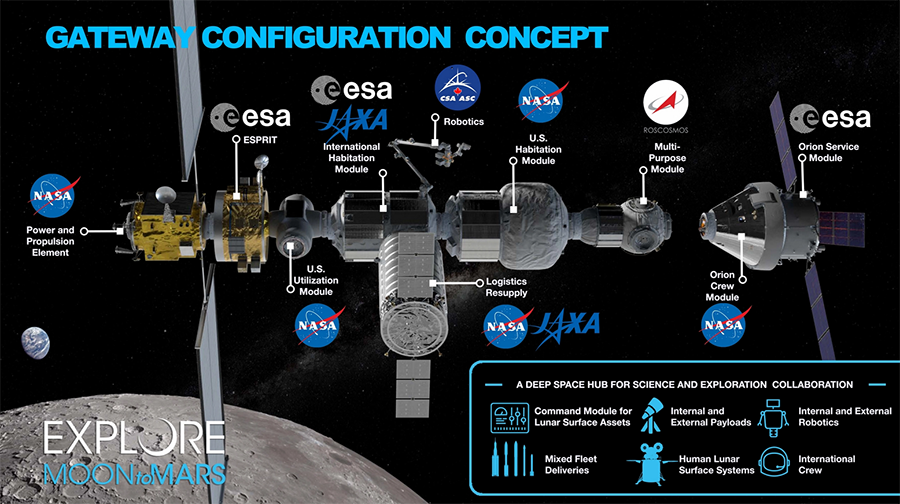 America’s plans for a Lunar Gateway station now exclude Russia – a politically-motivated decision that will cost America in terms of technical expertise can capabilities Russia could offer the project.
America’s plans for a Lunar Gateway station now exclude Russia – a politically-motivated decision that will cost America in terms of technical expertise can capabilities Russia could offer the project.
America’s exclusion of China from virtually all cooperation with NASA including on the International Space Station would at first serve to hinder China’s space program – but now appears to be spurring it.
China now plans to launch its own space station and will use it to cooperate with any and all nations in space – including those thus far excluded by US-dominated projects.
These are possibilities that are no longer the domain of science fiction writers but the serious topics of policymakers and the aerospace branches of national armed forces around the globe.
Satellite-killing missiles, moon bases, Mars rovers, space stations, rockets taking off and landing under the power of their own engines – are fast becoming a reality or in some cases, are already here.
The new space race has begun and it is a race a growing number of nations and companies are joining on a nearly monthly basis.
Rockets are taking off from traditional launch sites in Florida and Kazakhstan – but also now from places like New Zealand and Amur Oblast in eastern Russia. SpaceX is building a spaceport in Boca Chica, Texas, near America’s border with Mexico. And China is constructing new launch facilities on land and at sea.
The scale and importance of activity in space is expanding rapidly, with ever-expanding rewards of the wealth, power and influence for its participants. Wherever there are people and resources – there will be competition, and in this new space race we will likely see this competition move beyond flag-planting and toward something that resembles actual conflict.
***
VIDEO: Amazon founder Jeff Bezos presents his and others’ plans for the future of outer space. Watch:
Author Brian Berletic, formerly known under his pen name Tony Cartalucci, is Bangkok-based geopolitical researcher, writer and special contributor to 21st Century Wire. See more of his work at Tony’s archive. Over the last decade, his work has been published on a number of popular news and analysis websites, and also on the online magazine “New Eastern Outlook”. Also, you can follow him on VK here.
References:
New Eastern Outlook – China Completes its Beidou Satellite Navigation Network:
https://journal-neo.org/2020/
SpaceNews – ULA’s Tory Bruno argues for U.S. investments in the production of fuel in space:
https://spacenews.com/ulas-
Space.com – Inside ULA’s Plan to Have 1,000 People Working in Space by 2045:
https://www.space.com/33297-
Blue Origin – Going to Space to Benefit Earth:
https://youtu.be/GQ98hGUe6FM
TASS – Launch of Russian Amur rocket with reusable stage will cost $22 mln:
https://tass.com/science/
NASA – Mars Perseverance Rover:
https://www.nasa.gov/
CGTN – China’s Tianwen-1 enters Mars parking orbit:
https://news.cgtn.com/news/
JAXA – Hayabusa 2 Project:
https://www.hayabusa2.jaxa.jp/
NASA – OSIRIS-REx:
https://solarsystem.nasa.gov/
National Interest – GPS Jammed: Russia Is Messing with America’s F-35s:
https://nationalinterest.org/
New Eastern Outlook – The Problem With US Space Force:
https://journal-neo.org/2021/
READ MORE SPACE NEWS AT: 21st Century Wire Space Files
PLEASE HELP SUPPORT OUR WINTER FUNDRAISING DRIVE HERE















